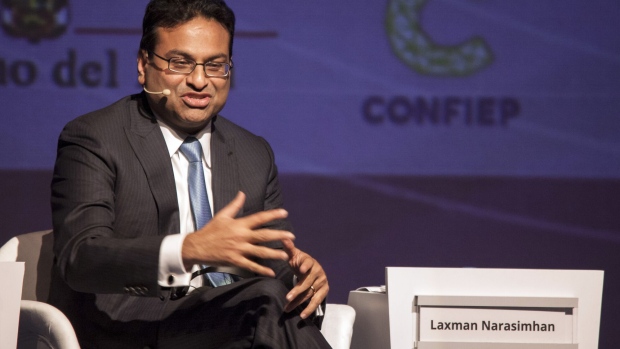May 1, 2024
Starbucks CEO’s Honeymoon Is Over After Sales Slump, Shares Dive
, Bloomberg News

(Bloomberg) -- Laxman Narasimhan’s honeymoon phase is over.
The Starbucks Corp. chief executive officer, just over a year in the job, saw shares dive by as much as 18% on Tuesday after the company cut guidance for a third straight quarter and posted the first sales decline since late 2020. The stock dropped the most intraday in nearly a decade.
To lure people back after a rough start to the year, Starbucks says it’s redoubling efforts to speed up service, add more discounts and introduce new products like a boba-inspired beverage while offering food to attract more customers outside of peak morning hours.
The coffee chain also said it needs to do a better job of serving customers on its app. Some users grew frustrated by wait times last quarter, prompting them to abandon their mobile orders. At the same time, products Starbucks was promoting, such as its potato, cheddar and chive bake, weren’t widely available — another problem the company is pledging to solve.
It won’t be an instant fix. In a sign that Starbucks expects more pain ahead, the chain cut its full-year revenue growth forecast to a low-single-digit percentage from as much as 10%. Adjusted earnings per share could be flat.
The downbeat performance raises questions about how Narasimhan will bring customers back to Starbucks, which as recently as November said demand for iced shaken espressos was resilient and expressed confidence in its forecast.
“The significant reversal of fortune for Starbucks begs the question of whether bigger — and tougher — issues are afoot, such as if the company has overreached on price or if the brand’s appeal has lost some of its luster,” William Blair analyst Sharon Zackfia said in a note to clients.
Narasimhan will have to convince investors — including his predecessor, Howard Schultz — that his plan will be enough as persistent inflation tests demand for little treats. Starbucks “lacks a cogent plan to boost demand,” said Michael Halen and Amir Islam at Bloomberg Intelligence.
The apparent step up in new product launches also raises questions about how easily baristas can handle the menu changes, according to Stifel analyst Chris O’Cull. And even with lowered targets, Starbucks will be in “a show-me state” about whether it can reignite growth, Zackfia said.
To be sure, some analysts say they think Starbucks can right the business. The issues the company is facing have “proven to be fixable” in the past, said BTIG analyst Peter Saleh, who cut his price target for the stock but has maintained a buy recommendation.
Far Cry
It’s a far cry from the state of affairs that Narasimhan inherited from Schultz, who stepped down from his third stint as CEO in March of last year. Schultz returned to help usher the company through the pandemic and contend with a growing unionization movement. The company spent about six months searching for a successor and another half-year training Narasimhan for the role under Schultz.
At the time, Starbucks was struggling to meet elevated demand for its beverages, including the increasingly popular cold drinks. Schultz hatched a plan to help Starbucks adapt and laid out lofty growth goals that Narasimhan had to carry forward.
Narasimhan came over from British consumer-goods company Reckitt Benckiser Group Plc, where he was known for making fast changes to turn around the struggling business. Starbucks, by contrast, was meant to be a growth story fueled by revenge-spending among consumers seeking affordable indulgences.
Now, Starbucks is contending with a pullback from price conscious-consumers. Even the number of active domestic rewards members — who are usually its most loyal fans — took a rare dip in the quarter. The company has also pointed to misperceptions regarding its stance on the Israel-Hamas war as hurting its Middle East business.
See Also: Whirlpool Bets Starbucks Fans Will Buy a $2,000 Espresso Maker
“If the sales challenges were skewed more to ‘misinformation’ issues about the brand, the market would view them as transient,” Guggenheim Partners analyst Gregory Francfort wrote in a note. But infrequent customers are avoiding the brand because of its perceived high prices, he said, “which means that fixing these issues could be a bigger lift.”
©2024 Bloomberg L.P.






